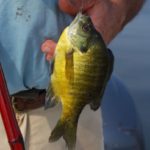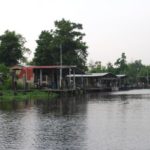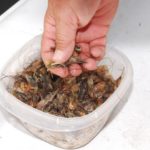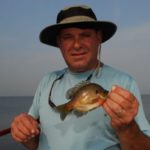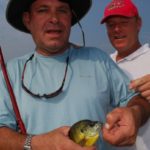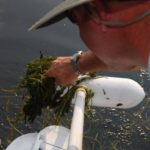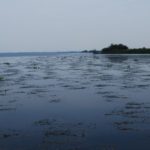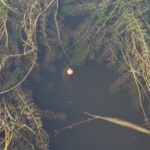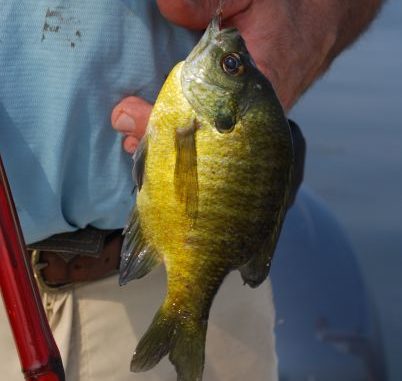
Lake Cataouatche’s east side gets none of the glory, but it’s absolutely loaded with big summertime bluegill.
When I first moved to New Orleans as a (very) young man in the mid-1960s, I just knew that I was a fishing hot dog. I thought I knew all there was to know about catching bass, bream, white perch and catfish — and that’s where the fishing world ended.
While I was expounding on the virtues of these freshwater fish during a break in a sales meeting, I noticed a kind-hearted co-worker, Grant “Popsy” Rodriguez, watching me in bemusement. Over lunch after the meeting, he pulled me down to earth and explained the fishing facts of life, a la New Orleans, to me.
While I can no longer quote his exact words, what he told me in his elegant Irish Channel dialect was roughly thus. In “New Oily-ins” real fishermen only fish for speckled trout, pompano, flounder and red snapper. Redfish were a rough fish — edible (barely), but rough.
As for freshwater fish, he laughed until his sides hurt at the thought of eating anything kin to a hardhead catfish. He knew, of course, that some people without boats went to City Park to catch “green trout” (largemouth bass) and he had actually heard that some folks somewhere fished for “poich” (bluegills and other sunfish). But he quickly added that no one actually ate any of these creatures as they had a “muddy taste.”
It was a good lesson, followed by another. Popsy took me to his camp on Wilkinson Canal in Plaquemines Parish and slimed my hands on speckled trout. The trip started a long-term love affair with swimming quicksilver, but I never really got over my earlier fling with bream (perch to New Orleanians).
That was why my head whipped up from the book I was signing at the Louisiana Sportsman’s Show when Gary Hayes said, “You really oughta come fish perch with us in Lake Cataouatche sometime.”
“When?” I fired back.
Just like that the trip was on.
Before the trip, Hayes called to prep me.
“We will be fishing on the other side of Lake Cataouatche,” he said. “The Davis Pond Freshwater Diversion has made the west side of the lake real popular with fishermen. We will be on the northeast side.
“We’ll be fishing perch in pockets or holes of open water in grass beds along the shore of the lake. It will not be bed fishing, so we will move a lot.”
The beds Hayes referred to are dense concentrations of bluegill nests that are the favored target of most bream fishermen in the summertime.
Perch fishing in Cataouatche, explained Hayes, starts in May, peaks in June when catfish show up and plays out in September. This was prime time, and everything was promising.
I met Hayes and Guy Clesi, his regular fishing partner of 19 years, at what locals call the Shrimp Lot, an area set aside for seafood venders on the corner of Louisiana Avenue and Westbank Expressway in Westwego. They weren’t hard to spot. Clesi had a 22-foot Sea Hunt bay boat hung on the back of his truck.
The two men launched almost next door at the public launch just north of the state park. After idling past the park’s launches and under the soaring Lapalco Boulevard Bridge, Clesi turned the boat hard right out of Bayou Segnette and into the back levee canal.
Most of the several-mile run was not pretty. Power lines flanked one side of the canal and a hurricane protection levee the other. But I got to know the two men during the easy ride. Clesi, a native New Orleanian, started fishing Joe Brown’s Pond in New Orleans East.
“Perch are fun,” he said. “You can see the action right in front of you. My 9- and 12-year-old kids love catching fish.”
Hayes, 50, is seven years Clesi’s senior. Hailing originally from Hammond, he fished farm ponds and the Bogue Chitto River with his cousins in Franklinton. With Clesi, he now pursues his first love, sight fishing for redfish, although he chases speckled trout year round and makes a bunch of Cataouatche perch trips every summer.
At the first intersection, Clesi turned the boat left into Whiskey Canal. It was like turning the clock back 75 years. Rustic camps in various states of repair and disrepair lined both sides of the canal. Rusty tin and weathered wood were the order of the day. No power lines marred the image. If you had electricity at one of these camps, it was from your own generator.
The camp-lined canal emptied into the vast open expanse of Lake Cataouatche. Clesi hung the boat tightly to the right, idled it through the grass beds for 50 yards, then stopped. It was a weekend — and it was dead quiet. Only the creaking trill of redwing blackbirds rent the air.
“Listen to this — no sounds,” he said. “This is why we come to spots like this.”
Clesi dove into the big boat’s rod locker and pulled out — cane poles?
Yes, they were cane poles: the old, true-blue Calcutta cane poles, although these had metal joints to allow for easier storage. It didn’t seem to fit — cane poles in a $36,000 fiberglass bay boat.
“We use cane poles rather than fiberglass because of tradition,” he explained. “They are harder to find, but I know that the Conoco Station and bait shop in Westwego still has them. He is the guru of bait around here.”
In another bow to tradition, the poles didn’t have those cute little reels mounted on them. A length of 10-pound-test monofilament just shorter than the 12-foot pole was tied directly to each pole’s small end.
Using poles instead of rods and reels also served a practical function. Baits could be dropped straight down into small weed-free holes in the grass beds. Attempting to reel in a bait would quickly catch a load of aquatic plants.
Both men used a pear-shaped sliding cork, set at between 3 and 4 feet, with the objective being to keep the bait off the bottom. Hayes used a No. 6 Mustad hook and Clesi used a small tube jig head. For weight, Hayes crimped on this line the second-smallest size of split shot about 6 inches up from the hook.
The sliding cork was functional as well. A cork permanently set at several feet would have made placing the baits in the often small holes with precision more difficult.
Hayes broke two plastic, snap-lid freezer containers out of the ice chest. One held shrimp heads, which he periodically flicked out in small handfuls as chum while they were fishing. The other held their bait, small saltwater shrimp he had pre-cut into fingernail-size pieces.
“I prefer shrimp,” said Hayes, “because I think that perch and catfish prefer shrimp and they are easier to fool with.
“Crickets and worms will work, but worms are messy and I don’t have good luck keeping crickets from escaping and having crickets all over the boat.”
It was still early when the pair started picking up fish, mainly catfish. All were under 14 inches long. Blue and channel catfish appeared in equal numbers.
“A co-worker named Danny Gasser told us about fishing this area for perch three years ago,” explained Clesi, as he unhooked his third or fourth catfish. “It was close to home and easy fishing, but the number of catfish here surprised us. They are perfect sized — 10 to 12 inches.”
“Good eating size,” interrupted Hayes. “They are a little sweeter than bigger cats. I bronze them, two minutes per side in a pan until they get a little crusty.”
“They are now as much of a target as the perch,” said Clesi, grinning broadly.
He had unhooked two more catfish and was ahead of Hayes.
As the pair fished, I admired the vast grass beds that extended into the lake from shore for 50 to 75 yards. There was no pattern to where they fished. They simply and slowly trolled and drifted the boat through the less dense spots in the plant beds. Whenever the boat stopped, Hayes would flick a few pinches of shrimp heads in the open pockets, which they followed with their baited hooks.
The man on the trolling motor clearly had the toughest job. He had to stop often, partially raise the trolling motor and pull clumps of plants off of the trolling motor head and prop.
“Fishing isn’t nearly as good early in the year when grass beds aren’t here,” explained Hayes. “I consider them necessary because perch and catfish like the habitat.
“By July and August, the grass beds are denser and extend further into the lake. We can’t fish inside them like we are now, but we just fish the outside edges.
“There are grass beds on the other side of the lake [the west side] too, but that’s where all the bass fishermen are. I am a less traveled kind of guy,” he chuckled. “With the (Davis Pond Freshwater Diversion) adding fresh water and the stocking of Florida bass, everybody is bass fishing except for a few guys at the camps.”
By 8 a.m., the perch started biting steadily and by 9 a.m., they came on strong. All the perch they caught were bluegills and just as Hayes had promised, they weren’t bedded perch — they were pocket perch. Bedded bluegills are almost all dark-colored males aggressively defending their nests. Half these fish were plump, greenish-yellow females. These weren’t the big crease-faced bull bluegills of the Atchafalaya Basin, but they averaged hand-sized — plenty big enough to fillet.
When the perch bite picked up, the catfish bite didn’t slacken. It was addictive, so both men stayed busy. The bites were easy to tell apart. Catfish hit the bait hard and the cork disappeared underwater in an eye blink. Bluegills either picked up the bait and held it, causing the cork to jiggle and lay over on its side, or they slowly swam down and away with the bait, dragging the cork after them.
The fishing was a combination of relaxation and competition. Hayes, with one eye peeled for what Clesi was doing, commented that this was an “easy Sunday morning — not running and gunning.” For his part, Clesi was fabricating his own tune to the words of “easy like Sunday Morning.” But one of his eyes in turn was on Hayes.
There was constant chatter and good-natured ribbing about who was ahead in the count, which was lost after the first four or five fish, giving both men room to claim the lead. Clesi glanced at me, flashed a toothy grin and said, “Don’t ever let one of us get three or four fish ahead of the other. He’ll never come back.”
By 10 a.m., Hannuh was doing her work. It was hot, sultry and oppressively still. Even though the best part of the day for bluegill fishing was ahead, Hayes and Clesi decided that they didn’t need to stuff the box with fish, and stowed their poles for the ride in.
Hayes nudged the ice chest, as Clesi idled out of the grass bed.
“In Louisiana we are all about having a good meal,” he said. “That’s why I fish. And I can stop at the Shrimp Lot on the way home.”
